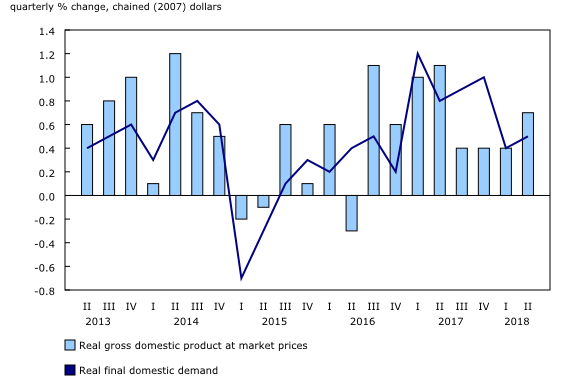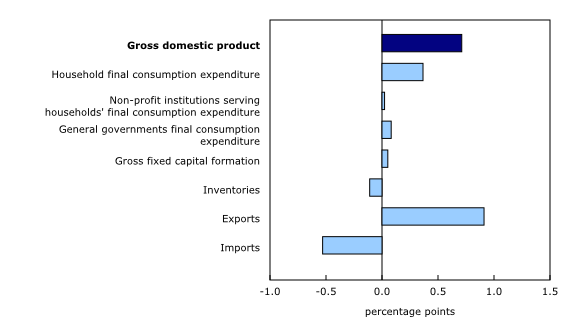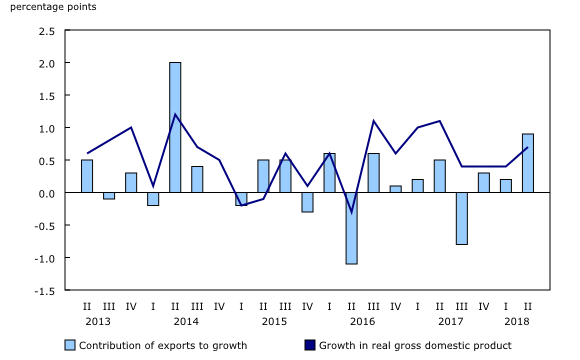Gross domestic product, income and expenditure, second quarter 2018
Archived Content
Information identified as archived is provided for reference, research or recordkeeping purposes. It is not subject to the Government of Canada Web Standards and has not been altered or updated since it was archived. Please "contact us" to request a format other than those available.
Released: 2018-08-30
Real gross domestic product (GDP) growth accelerated to 0.7% in the second quarter, following a 0.4% gain in the first quarter. Meanwhile, final domestic demand rose 0.5%.
Growth was mainly driven by a 2.9% increase in export volumes—the largest gain since the second quarter of 2014. Exports of goods, led by energy products, rose 3.6% after increasing 0.3% in the first quarter. Exports of services edged down 0.2%, the first decline since the fourth quarter of 2015.
Household spending rose 0.6%, after increasing 0.3% in the first quarter. Outlays on services (+0.8%) was the largest contributor to the increase. Rebounds in semi-durable (+1.2%) and non-durable (+0.2%) goods and continued growth in durable goods (+0.5%) also contributed to the gain.
Businesses continued to accumulate inventories, adding $13.4 billion to their stock, following a $16.0 billion increase in the previous quarter. Both non-farm and farm inventories rose in the second quarter.
Business investment in non-residential structures (+0.5%), machinery and equipment (+0.3%) and intellectual property products (+0.2%) all decelerated in the second quarter. Housing investment grew 0.3%, following a 2.7% decline in the previous quarter.
Expressed at an annualized rate, real GDP was up 2.9% in the second quarter. In comparison, real GDP in the United States grew 4.2%.
Exports drive overall growth
Growth in export volumes accelerated to 2.9% in the second quarter, due in part to notable increases in energy products (+5.6%) and consumer goods (+6.3%), particularly pharmaceutical products. Exports of aircraft, aircraft engines and aircraft parts (+13.4%) increased sharply on higher shipments of business jets to both the United States and non-US countries. Exports of services edged down 0.2%.
Total import volumes rose 1.6% in the second quarter, compared with 1.0% growth in the first quarter. Imports of goods increased 1.7%. Imports of refined petroleum energy products rose 45.1% to offset the complete shutdown of four Canadian refineries in April and May. These shutdowns typically occur once every five years. Additionally, aircraft and other transportation equipment and parts grew 9.1%. Imports of services (+1.1%) rebounded following a 0.8% decrease in the previous quarter.
Consumer spending accelerates
Household final consumption expenditure increased 0.6%, twice the pace of the first quarter and reversing the downward trend over the previous three quarters. Growth was largely attributable to outlays on services (+0.8%), which outpaced outlays on goods. Housing-related expenses (housing, water, electricity, gas and other fuels), up 0.6%, contributed the most to the widespread growth.
Spending on goods grew 0.5% following a flat first quarter, with rebounds in semi-durable (+1.2%) and non-durable (+0.2%) goods. Purchases of vehicles declined 0.5%.
Housing investment increases
Investment in housing increased 0.3% in the second quarter, following a 2.7% drop in the first quarter. Declines in ownership transfer costs (-3.4%) continued, while new constructions (-0.3%) contracted for the first time since the third quarter of 2016. However, these declines were more than offset by a sharp 2.9% increase in outlays on renovations.
Business investment decelerates
Business gross fixed capital formation increased 0.4%, the slowest pace since the fourth quarter of 2016, as investment growth in non-residential structures, machinery and equipment, and intellectual property products all decelerated in the second quarter.
Machinery and equipment investment rose 0.3% following a 3.9% increase in the first quarter, with aircraft and other transportation equipment (+5.8%), industrial machinery and equipment (+0.7%) and computers and computer peripheral equipment (+1.8%) accounting for the majority of the growth.
Businesses accumulate inventories
Businesses added $13.4 billion to inventories in the second quarter, less than the $16.0 billion accumulated in the previous quarter. Most of the accumulation came from wholesalers (+$9.0 billion), with manufacturers (+$2.8 billion) also adding to their stock.
Investment in retail inventories declined to $0.5 billion, while farm inventories increased $0.9 billion.
Economy-wide income increases
The GDP implicit price index, representing the price of goods and services produced in Canada, increased 0.5% in the second quarter, while real gross national income (the real purchasing power of income earned by Canadian-owned factors of production) rose 0.7%, the same pace as real GDP.
Gross operating surplus (in nominal terms) grew 2.1%, compared with a 0.5% gain in the first quarter, as earnings of energy producers were boosted by higher crude oil prices and volumes.
Household disposable income rose 0.7%, up slightly from the previous quarter (+0.6%). Compensation of employees increased 0.7%, the slowest pace since the third quarter of 2016. The household saving rate fell from 3.9% in the first quarter to 3.4% in the second quarter, as household spending outpaced disposable income.
Sustainable Development Goals
On January 1, 2016, the world officially began implementation of the 2030 Agenda for Sustainable Development—the United Nations' transformative plan of action that addresses urgent global challenges over the next 15 years. The plan is based on 17 specific sustainable development goals.
Gross domestic product, income and expenditure is an example of how Statistics Canada supports the reporting on the Global Goals for Sustainable Development. This release will be used in helping to measure the following goals:


Note to readers
For information on seasonal adjustment, see Seasonally adjusted data – Frequently asked questions.
Percentage changes for expenditure-based statistics (such as personal expenditures, investment, exports and imports) are calculated from volume measures that are adjusted for price variations. Percentage changes for income-based and flow-of-funds statistics (such as labour income, corporate profits, mortgage borrowing and total funds raised) are calculated from nominal values; that is, they are not adjusted for price variations.
There are two ways of expressing growth rates for gross domestic product (GDP) and other time series found in this release:
- Unless otherwise stated, the growth rates in this release represent the percentage change in the series from one quarter to the next, such as from the first quarter of 2018 to the second quarter of 2018.
- Quarterly growth can be expressed at an annual rate by using a compound growth formula, similar to the way in which a monthly interest rate can be expressed at an annual rate. Expressing growth at an annual rate facilitates comparisons with official GDP statistics from the United States. Both the quarterly growth rate and the annualized quarterly growth rate should be interpreted as an indication of the latest trend in GDP.
Debt service ratio
Starting with the second quarter 2018 release, the debt service ratio table 36-10-0435 (formerly CANSIM 380-0073) will be published in the quarterly release of the Financial and wealth accounts in table 11-10-0065: National balance sheet accounts, debt service indicators, households on September 14. A mapping between the current and new series will be available upon request.
Revisions
Data on GDP for the second quarter have been released along with revised data from the first quarter of 2018. These data incorporate new and revised data, as well as updated data on seasonal trends.
Real-time tables
Real-time tables 36-10-0430-01 and 36-10-0431-01 will be updated on September 10.
Next release
Data on GDP by income and expenditure for the third quarter will be released on November 30.
Products
The Latest Developments in the Canadian Economic Accounts (13-605-X) is available.
The User Guide: Canadian System of Macroeconomic Accounts (13-606-G) is available.
The Methodological Guide: Canadian System of Macroeconomic Accounts (13-607-X) is available.
Contact information
For more information, or to enquire about the concepts, methods or data quality of this release, contact us (toll-free 1-800-263-1136; 514-283-8300; STATCAN.infostats-infostats.STATCAN@canada.ca) or Media Relations (613-951-4636; STATCAN.mediahotline-ligneinfomedias.STATCAN@canada.ca).
- Date modified:





